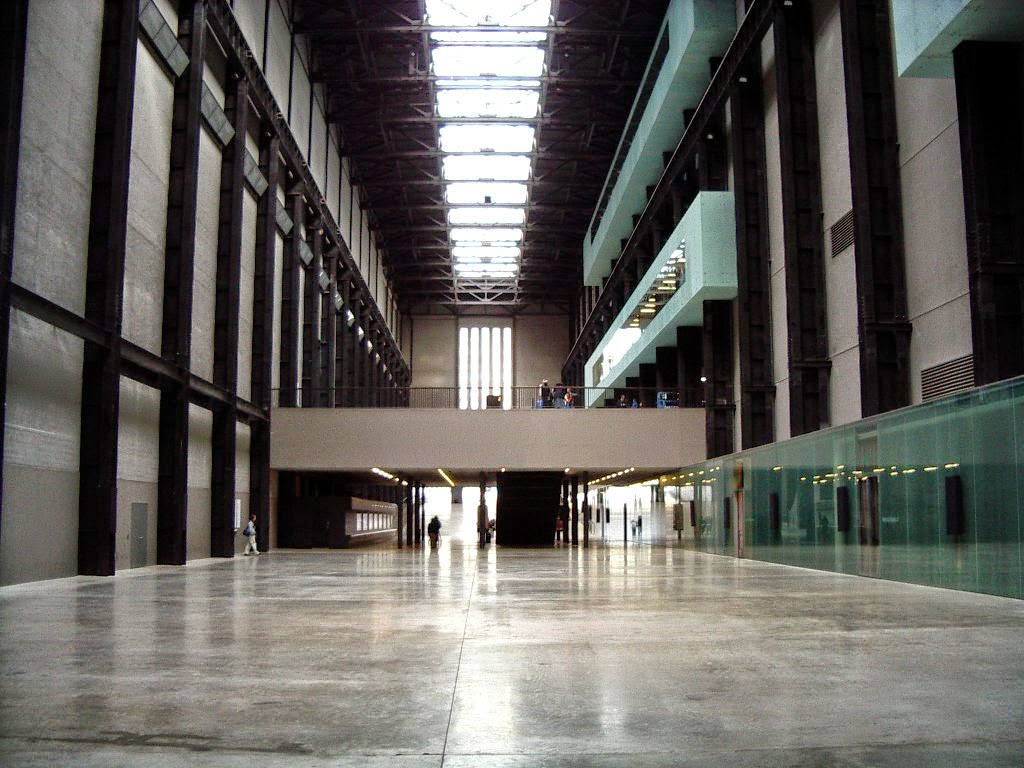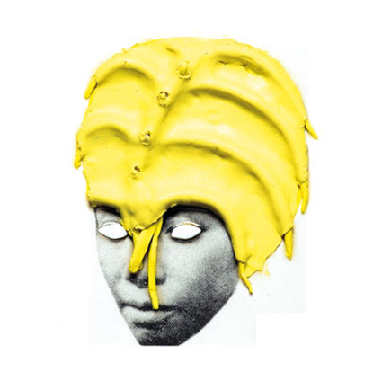ELLEN GALLAGHER : AxME AT TATE MODERN
May 1, 2013 – September 1, 2013
ELLEN
GALLAGHER : AxME AT TATE MODERN
May 1, 2013 –
September 1, 2013
Ellen Gallagher is one of the most acclaimed
contemporary artists to have emerged from North America since the mid-1990s.
Her gorgeously intricate and highly imaginative works are realised with a
wealth of virtuoso detail and wit. This is her first major solo exhibition in
the UK, providing the first ever opportunity to explore an overview of her
twenty-year career.
Gallagher brings together imagery from myth, nature,
art and social history to create complex works in a wide variety of media
including painting, drawing, relief, collage, print, sculpture, film and
animation. The exhibition explores the themes which have emerged and recurred
in her practice, from her seminal early canvases through to recent film
installations and new bodies of work.
In her series of wig-map grid collages, Double Natural, POMP-BANG, and eXelento, Gallagher has appropriated
and incorporated found advertisements for hair and beauty products from the
1930s to the late 1970s from publications such as Ebony, Our World,
and Black Stars. These
advertisements fostered ideals in black beauty through wigs and hair
adornments, which Gallagher has then recontextualised, collaging the Afro wig
elements and embellishing them with plasticine. As she comments: ‘The wig
ladies are fugitives, conscripts from another time and place, liberated from
the “race” magazines of the past. But again, I have transformed them, here on
the pages that once held them captive.’
The exhibition includes other such key works as Bird in
Hand 2006, a complex relief built up in layers of printed matter, plasticine,
crystal, paint, gold leaf and salt. In Bird in Hand, human life and marine life converge at
the bottom of the ocean in a mythical black Atlantis.
Gallagher’s mysterious vision of marine life extends
beyond the canvas and into other media, such as the 16mm film installation Murmur
2003 - 2004, as well as
the ongoing series of delicate watercolours and cut paper works entitled Watery Ecstatic. New and
recent work on display for the first time at Tate Modern include Morphia, a series of
two-sided drawings, which show how Gallagher combines the intimate with the
epic, the urban with the oceanic, the ethereal with the physical and history
with the present.
Ellen Gallagher was born in Providence, Rhode Island
in 1965 and now lives and works in Rotterdam and New York. Her work is held in
many major public collections, including MoMA and Metropolitan Museum of Art in
New York and Centre Pompidou, Paris.
DELUXE 2004 - 2005
Medium60 Works on Paper, Etching,
Screenprint, Lithograph with
Plasticine, Velvet, Toy Eyeballs and
Coconut Oil
DimensionsFrame (each): 389 x 325 x 46
mm
Overall Display Dimensions: 2149 x 4527 mm
Overall Display Dimensions: 2149 x 4527 mm
Collection: Tate
ELLEN GALLAGHER - DELUXE
DeLuxe is a portfolio of sixty
individually-framed prints hung in a rectangular grid formation comprising five
rows of twelve, arranged in a sequence fixed by the artist. The work’s raw
materials are advertisements drawn from magazines dating from the 1930s to the
1970s aimed at African American consumers, such as Ebony, Our World and Sepia. Extracts of textual
advertisements and images of mainly female models have been cut and layered to
create the effect of a collage. These advertisements promote a range of beauty
products for women and men, especially goods relating to hair including wigs
and pomades. Other publicity materials advertise items including slimming aids,
underwear, feminine hygiene items and skin treatments, such as bleaching
creams. Gallagher employed a variety of techniques to transform the
advertisements, combining traditional printing processes of etching and
lithography with recent developments in digital technology. The printed pages
are principally black and white, but are punctuated by areas coloured grey,
pink and red. With the title DeLuxe Gallagher draws ironically on the
language of the advertisements as part of her project of subverting their
original intentions; the word ‘deluxe’ appears in various spellings and fonts
in different places in the prints.
Following the printmaking process, Gallagher added a
range of decorative elements onto the surfaces of many of the images including
glitter, gold leaf and coconut oil – which has associations with Afro hair – as
well as three-dimensional elements, that transform the prints into reliefs.
These additions include toy eyeballs and pieces of intricately moulded coloured
plasticine resembling masks and hairpieces, which are placed over models’ faces
and heads. ‘Plasticine is meant to allude to [the] idea of mutability and
shifting’, the artist has explained (quoted in ‘Ellen Gallagher
Interview: eXelento and DeLuxe’).
Moreover, her delicate moulding and sculpting of the plasticine produces forms
that contrast with the geometry and order of the grid-like structure of the
various wig advertisements (which show rows of heads wearing wigs) as well as
the grid that the work as a whole forms.
With interventions such as covering up models’ faces
and whiting out or cutting out eyes, Gallagher emphasises the complexities
surrounding the construction of identity, specifically in relation to race and
gender. The artist’s use of collage to unite different parts of a range of
models’ pictures and the addition of extravagant new hairstyles onto female
heads advertising wigs produces unsettling juxtapositions. These
transformations parody the ‘improvements’ offered by the advertisements and
underscore in particular the role of hair as a signifier of difference. In one
print derived from an advertisement for ‘Duke’ hair pomade, the artist covered
the face of a black male model with yellow plasticine fashioned in a stylized
shape suggesting an African mask. The mask that obliterates the face contrasts
sharply with the model’s elegant suit and cigarette-holding hand.
Making modifications to images drawn from old
magazines is characteristic of Gallagher’s practice. DeLuxe developed
directly from a series of magazine drawings that the artist produced for her
exhibition Preserve (Drawing
Center, New York, 2002). In terms of its size and
complexity, DeLuxe is reminiscent of the slightly earlier work Pomp-Bang 2003 (Museum of
Contemporary Art, Chicago), a vast canvas supporting some 396 images also
derived from advertisements.
For Gallagher the process of transforming images, as
in DeLuxe, is integral to the meanings generated by the finished works. It
is an activity that implies close and imaginative engagement with the figures
portrayed. Gallagher has commented:
What’s seen as political in [my] work is a kind of
one-to-one reading of the signs as opposed to a more formal reading of the
materials ... I think people get overwhelmed by the super-signs of race when,
in fact, my relationship to some of the more over-determined signs in the work
is very tangential. What I think is more repeated than that in the work is a
kind of mutability and moodiness to the signs ... And I think that’s where you
can talk about race in my work ... that idea of the abstract ‘I’ ... what it
means to look at somebody who was eighteen in 1939 ... whatever she was. That’s
specificity. It’s impossible to know who that was. But try anyway to have some
kind of imaginative space with that sign ... Sometimes it’s hard for people who
don’t make things to understand labor, joy, attention, and whimsy. But it’s in
the work – I don’t think it’s something I need to explain.
(Quoted in ‘Ellen Gallagher
Interview: eXelento and DeLuxe’.)
Gallagher lives and works in both New York and
Rotterdam and made DeLuxe mainly in New York in collaboration with
Two Palms Press. Tate’s version is one of four printer’s proofs from an edition
of twenty.
THE TATE MODERN LONDON
THE TATE MODERN LONDON
In December 1992 the Tate Trustees announced their intention
to create a separate gallery for international modern and contemporary art
in London.
The former Bankside Power Station was selected as the new
gallery site in 1994. The following year, Swiss architects Herzog & De
Meuron were appointed to convert the building into a gallery. That their proposal
retained much of the original character of the building was a key factor in
this decision.
The iconic power station, built in two phases between 1947
and 1963, was designed by Sir Giles Gilbert Scott. It consisted of a stunning
turbine hall, 35 metres high and 152 metres long, with the boiler house
alongside it and a single central chimney. However, apart from a remaining
operational London Electricity sub-station the site had been redundant
since 1981.
In 1996 the design plans were unveiled and, following a £12
million grant from the English Partnerships regeneration agency, the site was
purchased and work began. The huge machinery was removed and the building was
stripped back to its original steel structure and brickwork. The turbine hall became a
dramatic entrance and display area and the boiler house became
the galleries.
Since it opened in May 2000, more than 40 million people
have visited Tate Modern. It
is one of the UK’s top three tourist attractions and generates an
estimated £100 million in economic benefits to London annually.
In 2009 Tate embarked on a major project to
develop Tate Modern. Working again with Herzog & de Meuron,
the transformed Tate Modern will make use of the power station’s
spectacular redundant oil tanks, increase gallery space and provide much
improved visitor facilities.
http://www.tate.org.uk/about/who-we-are/history-of-tate
THE TATE MODERN LONDON
DELUXE 2004 - 2005
ARK ( FRONT ) 2014
ARK ( BACK ) 2014
UNTITLED 2013
Oil, Ink, and Paper on Canvas
Dimensions: 61 x 61 cm
Oil, Ink, and Paper on Canvas
Dimensions: 61 x 61 cm
© Gagosian Gallery
PRESERVE, DETAIL 2001
© Ellen Gallagher, Courtesy the
Artist
BIRD IN HAND 2006
Oil Paint, Ink, Paper, Polymer, Salt
and Gold Leaf on Canvas
Dimensions: Support: 2383 x 3072 mm
Collection: Tate
ESIRN COALER 2007
Medium Plasticine and Aluminium
Dimensions:: 894 x 552 x 45 mm
Collection: Tate
Acquisition: Presented by the Artist
2007
STADIA I – 2004
MURMUR 2003 - 2004
MediumFilm, 16mm, 7 Projections
Dimensions: Overall Display Dimensions
Variable
Collection: Tate
Acquisition: Presented by the American
Fund for the Tate Gallery,
Courtesy of the American Acquisitions
Committee 2012
OH SUSANNA 1993
Collection of Joan & Michel Salke ©
Ellen Gallagher
Courtesy of the Artist and Diego Cortez
Arte Ltd, New York
PAPER CUP 1996
HARE 2013
Ink, Watercolor, Oil,
Pencil, and Cut Paper on Paper
Dimensions: 113.8 x
118.4 cm
Private collection,
courtesy Hauser & Wirth. Photo by Ernst Moritz
ELLEN GALAGHER 1965
American artist Ellen Gallagher has Irish and African
American origins, which have shaped the texture and subject matter of her
practice. Sources include the vaudeville tradition of black minstrels, science
fiction and advertising targeted at African Americans.
Gallagher has relied on the repetition and revision
of minimalist structures since her early career; the subtle shifts and
repetitions in the writing of Gertrude Stein have long been an influence, along
with the sublime paintings of Agnes Martin. Minimalist geometry is used as an
empty shell into which controversial or taboo subject matter relating to
gender, race and history is inserted.
In the mid 1990s Gallagher began a series of large
scale work including Paper Cup,
which envelopes the viewer in a textured, apparently abstract surface which is
actually a historic cosmology of repeated shapes – the rubbery lips, bow ties
and rolling eyes of the vaudeville minstrels. In 1998 she developed a related
series of black enamel paintings, inscribing the dark surface with calligraphic
features relating to the minstrel stereotype.
Recent developments have seen Gallagher collecting
and appropriating images from magazines aimed at African American women, many
of them suggesting the use of prosthetic enhancements to diminish blackness. In
collaging a range of materials into the surfaces, including plasticine, rubber
and coconut oil, Gallagher adds her own humorous prostheses, developing a
personal visual language.
Gallagher’s work expresses on the one hand how to be
in the present, pushing forward the traditions and boundaries of painting; on
the other, it reminds the viewer that however insignificant they may become,
designations from the past continue to multiply and form part of the texture of
the world today.
















































%2B2014.jpg)
%2B2014.jpg)















